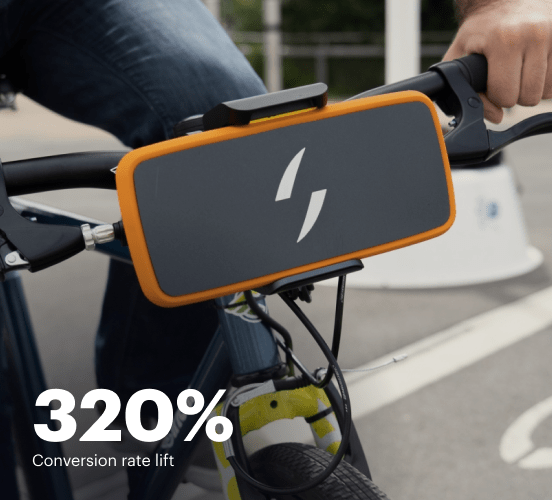Tilda vs. Elementor: the best platform for a seamless web experience
Discover how Tilda compares to Elementor regarding features and usability. Find out which platform provides the competitive advantage your business deserves.
Get startedSee how Instapage stacks up against the competition
| Feature | Instapage | Other builders |
| Drag-and-Drop Tools | ||
| Conversion-optimized templates | ||
| Manual and AI-powered A/B Tests | ||
| AI content suggestions | ||
| Popups and sticky bars | ||
| Canvas and grid blocks | ||
| Reusable and global elements | ||
| Form and popup builders | ||
| Built-in Heatmaps | ||
| Central analytics dashboard | ||
| Ad-to-page personalization and collections | ||
| Contacts, lists, and email | ||
| Dedicated, full-service CRO experts | ||
| Enterprise-ready platform |
Leading the way in building high-performing landing pages





Why Instapage is the smarter choice for your campaigns
Get everything you need to build, scale, and optimize high-converting landing pages—without coding.

Easier page building without coding
Instapage offers a flexible and seamless page creation experience with a library of 500+ conversion-focused layouts, Instablocks®, a drag-and-drop builder, and AI content generation. With technologies like Thor Render Engine®, you can create on-brand, mobile-responsive landing pages that load quickly and start converting during initial visitor clicks.

More insights — better results
Instapage lets you see in detail how each landing page experience and variation is performing so you can make targeted changes that boost page conversions. Use heatmaps for a better understanding of on-page activities, run A/B tests and AI-assisted experiments, and then track and evaluate results within robust analytics dashboards.

More personalized experiences
Instapage lets you quickly create high-performing landing pages tailored to each of your ad campaigns. Deliver personalized experiences for distinct audiences using dynamic text replacement. Effortlessly align specific advertisements to unique pages with AdMaps. Monitor audience-level metrics using our advanced data tools.

Built-in collaboration
Instapage collaboration capabilities bring your entire team together to speed up the process of landing page review, approval, and launch. No more frustrating and unnecessary revisions or edits scattered across emails. Provide instant feedback, conduct real-time page edits, and securely share your pages with outside stakeholders.

Free up time for your business
Invest time into business growth, not busy work. Launch landing pages faster with reusable forms and templates. Build once, reuse forever.
Explore all integrations






Easier page building without coding
Instapage offers a flexible and seamless page creation experience with a library of 500+ conversion-focused layouts, Instablocks®, a drag-and-drop builder, and AI content generation. With technologies like Thor Render Engine®, you can create on-brand, mobile-responsive landing pages that load quickly and start converting during initial visitor clicks.
More insights — better results
Instapage lets you see in detail how each landing page experience and variation is performing so you can make targeted changes that boost page conversions. Use heatmaps for a better understanding of on-page activities, run A/B tests and AI-assisted experiments, and then track and evaluate results within robust analytics dashboards.
More personalized experiences
Instapage lets you quickly create high-performing landing pages tailored to each of your ad campaigns. Deliver personalized experiences for distinct audiences using dynamic text replacement. Effortlessly align specific advertisements to unique pages with AdMaps. Monitor audience-level metrics using our advanced data tools.
Built-in collaboration
Instapage collaboration capabilities bring your entire team together to speed up the process of landing page review, approval, and launch. No more frustrating and unnecessary revisions or edits scattered across emails. Provide instant feedback, conduct real-time page edits, and securely share your pages with outside stakeholders.
Free up time for your business
Invest time into business growth, not busy work. Launch landing pages faster with reusable forms and templates. Build once, reuse forever.
Explore all integrationsGet started with Instapage in a few steps
-
Create your Instapage account
Start with Instapage by signing up via Google or your email. You'll get access to a free 14-day trial to discover Instapage capabilities. Feel free to cancel anytime during the 14-day trial if you decide that our product is not suitable for your business. -
Build and personalize your page
Create your first landing page from scratch or choose a template from 500+ customizable layouts. Use the drag-and-drop builder to add page elements, fonts, and backgrounds, refine content with AI, or add custom HTML, Javascript, and CSS. -
Review and make edits
Collaborate on page designs and streamline review processes. Invite your team members and stakeholders to review, edit, and provide feedback on your landing page. Collaborate knowing your page is confidential and only accessible to authorized users. -
Publish and track page performance
Publish your page to a domain or custom URL. Connect your pages to the ads you've created and track page performance within the analytics dashboard, run A/B tests and AI experiments, analyze results, and continuously optimize your landing page to maintain high conversions.
Tilda vs. Elementor: The Ultimate Digital Duel (Introducing Another Player)
As the digital landscape keeps evolving, the selection of the right landing page builder has become crucial for marketers and businesses alike. Among the myriad of choices, Tilda and Elementor stand tall, flaunting their unique capabilities and functionalities. But while these two titans fight for your attention, there’s an underdog lurking in the shadows—Instapage. Understanding how these platforms operate is vital for anyone looking to create effective landing pages. Are you a business owner, a marketer, or just someone intrigued by the options? Let’s dive deep into what these platforms offer, who might benefit from which, and how they differ from the looming presence of Instapage. Choosing a landing page builder isn't just about features; it's about finding the tool that fits your unique needs and aspirations—let’s explore this journey together.
Meet the Champions of Page Building
As we step into the arena of website creation, let's take a closer look at our contenders. Tilda is the sleek and stylish powerhouse, offering visually stunning templates and a user-friendly interface. It is perfect for those who prioritize aesthetics and require minimal coding knowledge. On the other hand, Elementor, known for its extensive widget library, brings flexibility and sophistication to the table. This platform is the go-to choice for those looking for creative freedom and dazzling functionalities. Both have carved a substantial niche in digital marketing, making themselves indispensable for marketers aiming to optimize conversions. However, just as the battle heats up, Instapage enters the ring, presenting its own unique features and advantages. With an emphasis on high-converting landing pages, Instapage positions itself as a serious contender that could give the giants a run for their money.
Feature Clash: What's on Offer?
When it comes to features, Tilda and Elementor both bring a variety of tools to the table. Tilda shines with its unique approach to block-based design, allowing users to build pages visually while maintaining design coherence. From its zero-block feature to varied content options, Tilda ensures that aesthetics aren't compromised while building functional pages. Conversely, Elementor boasts an impressive range of customizable widgets, allowing for detailed control over every aspect of your design. Yet, lurking behind the scenes, Instapage offers powerful A/B testing tools and robust analytics that can take your marketing game to the next level. It’s a feature showdown that reveals how each platform caters to different priorities in page-building.
Usability for Every Level: Navigating the Platforms
Now let's illuminate usability. Tilda's intuitive interface makes it a breeze for beginners looking to dip their toes into design without extensive prior experience. There’s a certain fluidity in how Tilda functions; it’s almost like a sandbox for your creativity. Elementor, however, offers a more intricate experience. While its functionality may initially appear overwhelming, seasoned marketers will appreciate the depth and control it provides once they become accustomed to it. In the meantime, the learning curve can be daunting for those not tech-savvy enough—where do you even begin? But just as the dust settles, Instapage’s straightforward UI dares to declare, ‘Let me show you the way!’ Its simplicity aids in overcoming the hurdles presented by its competition.
The Winning Features of Tilda:
- Unique block-based design allowing for creative flexibility.
- Extensive library of stylish pre-defined blocks for quick building.
- Zero-block feature for custom content creation with ease.
- Simple analytics to track page performance.
- Responsive designs that look good on any device.
The Stellar Features of Elementor:
- Rich assortment of customizable widgets for endless design possibilities.
- Mobile-friendly editing with responsive control.
- In-line editing for real-time updates and previews.
- Wide range of third-party integrations for enhanced functionality.
The Common Ground Between Them:
- Drag-and-drop editors that empower users of all levels.
- Responsive design capabilities ensuring mobile optimization.
- SEO-friendly tools to help improve visibility.
- Extensive template libraries with options for various industries.
- Integration with email marketing services for streamlined operation.
- User support forums and resources for troubleshooting.
In the end, it's evident that both Tilda and Elementor bring their unique strengths to the table, making them formidable players in the digital arena. But as we analyze their features, it becomes clear that Instapage is waiting in the wings as a serious contender, even claiming the title of ‘best value for money.'
Performance Face-off: Speed Matters
Let’s evaluate the performance of these digital powerhouses. Page loading times matter immensely, and in a world where speed is paramount, we want to ensure that each click doesn’t feel like running through molasses in the winter. Tilda is known for its quick load times, ensuring that users can access pages swiftly. In contrast, Elementor offers slightly variable performance based on the weight of the widgets and customizations. Efficiently optimizing these elements can lead to an impressive experience, but it requires more attention from the user. Now, Instapage enters the arena with an exceptional reputation for not just speed but also mobile responsiveness. It’s a performance punch-out that reminds users why choosing the right platform isn’t just about aesthetics; it’s about ensuring a smooth user experience.
The Support Teams: A Helping Hand
Every champion needs a support team, and when it comes to platforms, their customer service can make or break your experience. Tilda provides an array of resources, including tutorials and email support, making for an accessible user journey. Elementor, however, goes a step further, offering live chat support and a vibrant community forum where users can share tips, tricks, and solutions. Then there’s Instapage, with its dedicated customer support team that’s known to swoop in like a superhero, ready to resolve issues effectively. It’s comforting to know that help is always just a click away and that each platform brings its unique brand of support to the digital space.
Pricing Tactics: Which One Fits Your Wallet?
Understanding Tilda’s Pricing Advantages:
- Flexible pricing plans catering to different business needs.
- Affordable options make it accessible for startups.
- User-friendly pricing structures with no hidden fees.
Elementor’s Pricing Strategy: The Benefits:
- Variety of pricing tiers for individuals and agencies.
- Lifetime license option that offers value over time.
- Access to a vast library of templates with premium plans.
The pricing strategies here reveal notable distinctions. While Tilda offers straightforward and affordable options perfect for smaller businesses, Elementor’s structured tiers provide flexibility for both individual users and large agencies. However, Instapage stands tall with unparalleled flexibility in pricing, positioning itself as the best value for money with its extensive features.
Looking deeper into the pricing plans of our featured contenders shows that while you might find hidden surprises in unexpected areas, it’s essential to assess what you are getting for your money. Remember, investing in a platform often means more than just the initial cost—it's about the long-term value it brings to your business.
Instapage: The Unsung Hero
Amidst the skirmish between Tilda and Elementor, Instapage quietly waits, a mentor ready to share insights that the others might miss. With its A/B testing capabilities and tailored landing page features, Instapage provides businesses with the keys to optimizing conversion rates like no other. It’s here to ensure that landing pages are not just visually appealing but also functionally robust. So while the other platforms have their flairs, Instapage could just be the dark horse that transforms the way you think about landing pages. Its dedication to seamless user experience and conversion optimization elevates its status in the competitive landscape, making it a go-to for organizations serious about effective marketing.
In conclusion, the right choice relies heavily on your individual or business goals. As you consider these options—Tilda and Elementor on one side, with Instapage serving as a solid alternative—understand that each platform has its unique charm and capabilities. Take a step forward in your marketing journey with the right tool that aligns with your specific needs and aspirations.










